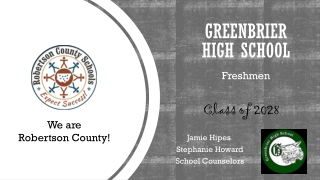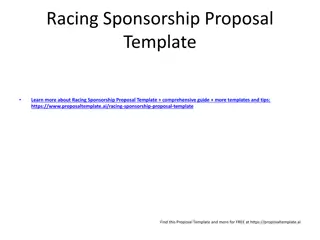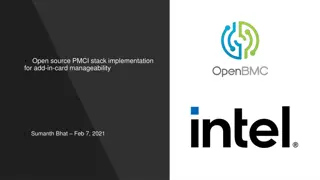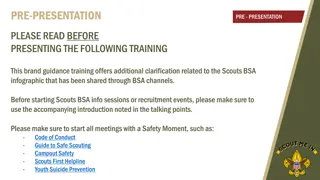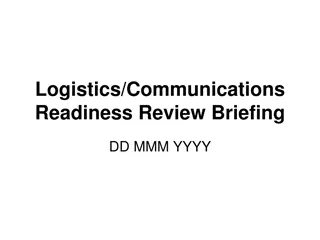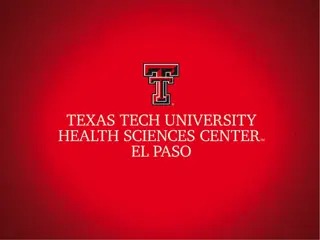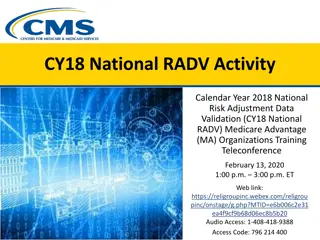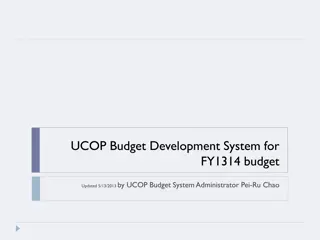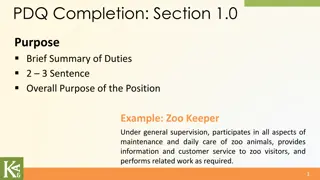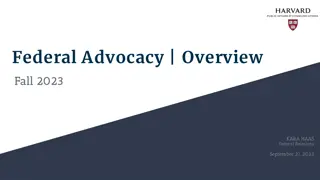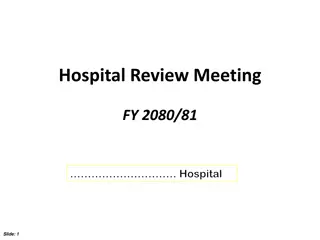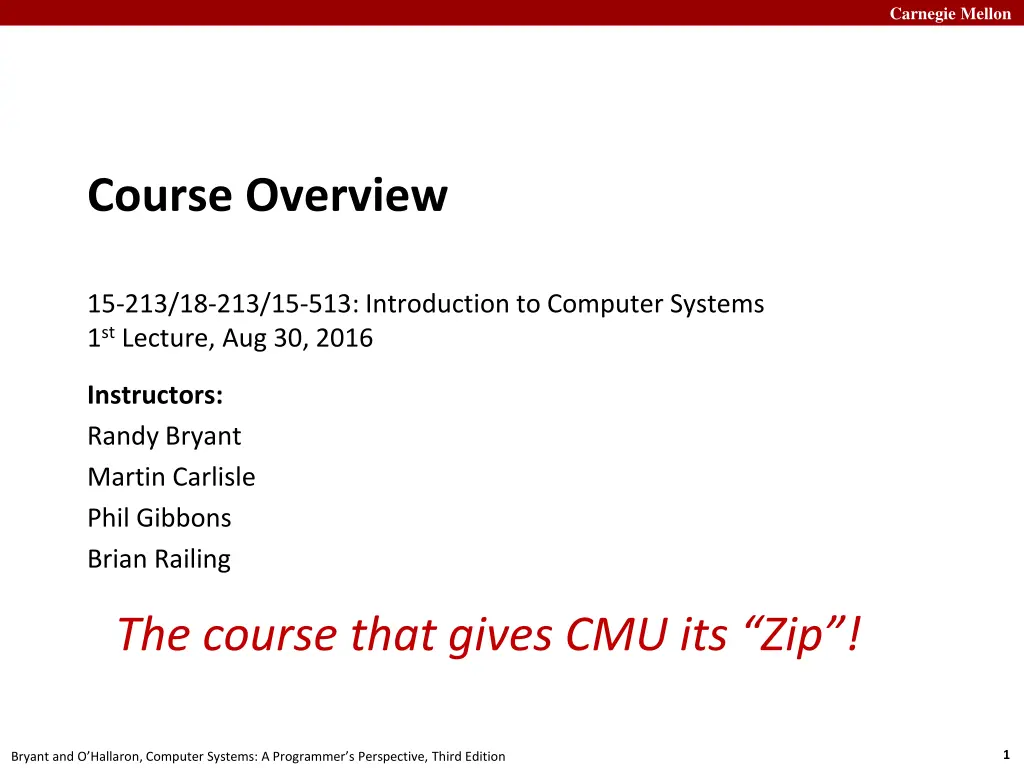
Unlocking the Power of Computer Systems: Carnegie Mellon Course Overview
Delve into the fundamentals of computer systems with Carnegie Mellon University's course, exploring how hardware and software combine to support application programs. Gain essential knowledge to enhance programming skills, troubleshoot efficiently, and optimize program performance for future CS/ECE classes. Understand the importance of understanding system workings beyond abstraction. Discover the reality behind integers and floats, and how they differ in computation.
Download Presentation

Please find below an Image/Link to download the presentation.
The content on the website is provided AS IS for your information and personal use only. It may not be sold, licensed, or shared on other websites without obtaining consent from the author. If you encounter any issues during the download, it is possible that the publisher has removed the file from their server.
You are allowed to download the files provided on this website for personal or commercial use, subject to the condition that they are used lawfully. All files are the property of their respective owners.
The content on the website is provided AS IS for your information and personal use only. It may not be sold, licensed, or shared on other websites without obtaining consent from the author.
E N D
Presentation Transcript
Carnegie Mellon Course Overview 15-213/18-213/15-513: Introduction to Computer Systems 1st Lecture, Aug 30, 2016 Instructors: Randy Bryant Martin Carlisle Phil Gibbons Brian Railing The course that gives CMU its Zip ! 1 Bryant and O Hallaron, Computer Systems: A Programmer s Perspective, Third Edition
Carnegie Mellon Overview Big Picture Course theme Five realities How the course fits into the CS/ECE curriculum Academic integrity Logistics and Policies 2 Bryant and O Hallaron, Computer Systems: A Programmer s Perspective, Third Edition
Carnegie Mellon The Big Picture 3 Bryant and O Hallaron, Computer Systems: A Programmer s Perspective, Third Edition
Carnegie Mellon Course Theme: (Systems) Knowledge is Power! Systems Knowledge How hardware (processors, memories, disk drives, network infrastructure) plus software (operating systems, compilers, libraries, network protocols) combine to support the execution of application programs How you as a programmer can best use these resources Useful outcomes from taking 213/513 Become more effective programmers Able to find and eliminate bugs efficiently Able to understand and tune for program performance Prepare for later systems classes in CS & ECE Compilers, Operating Systems, Networks, Computer Architecture, Embedded Systems, Storage Systems, etc. 4 Bryant and O Hallaron, Computer Systems: A Programmer s Perspective, Third Edition
Carnegie Mellon It s Important to Understand How Things Work Why do I need to know this stuff? Abstraction is good, but don t forget reality Most CS and CE courses emphasize abstraction Abstract data types Asymptotic analysis These abstractions have limits Especially in the presence of bugs Need to understand details of underlying implementations Sometimes the abstract interfaces don t provide the level of control or performance you need 5 Bryant and O Hallaron, Computer Systems: A Programmer s Perspective, Third Edition
Carnegie Mellon Great Reality #1: Ints are not Integers, Floats are not Reals Example 1: Is x2 0? Float s: Yes! Int s: 40000 * 40000 --> 1600000000 50000 * 50000 --> ? Example 2: Is (x + y) + z = x + (y + z)? Unsigned & Signed Int s: Yes! Float s: (1e20 + -1e20) + 3.14 --> 3.14 1e20 + (-1e20 + 3.14) --> ?? Source: xkcd.com/571 6 Bryant and O Hallaron, Computer Systems: A Programmer s Perspective, Third Edition
Carnegie Mellon Computer Arithmetic Does not generate random values Arithmetic operations have important mathematical properties Cannot assume all usual mathematical properties Due to finiteness of representations Integer operations satisfy ring properties Commutativity, associativity, distributivity Floating point operations satisfy ordering properties Monotonicity, values of signs Observation Need to understand which abstractions apply in which contexts Important issues for compiler writers and serious application programmers 7 Bryant and O Hallaron, Computer Systems: A Programmer s Perspective, Third Edition
Carnegie Mellon Great Reality #2: You ve Got to Know Assembly Chances are, you ll never write programs in assembly Compilers are much better & more patient than you are But: Understanding assembly is key to machine-level execution model Behavior of programs in presence of bugs High-level language models break down Tuning program performance Understand optimizations done / not done by the compiler Understanding sources of program inefficiency Implementing system software Compiler has machine code as target Operating systems must manage process state Creating / fighting malware x86 assembly is the language of choice! 8 Bryant and O Hallaron, Computer Systems: A Programmer s Perspective, Third Edition
Carnegie Mellon Great Reality #3: Memory Matters Random Access Memory Is an Unphysical Abstraction Memory is not unbounded It must be allocated and managed Many applications are memory dominated Memory referencing bugs especially pernicious Effects are distant in both time and space Memory performance is not uniform Cache and virtual memory effects can greatly affect program performance Adapting program to characteristics of memory system can lead to major speed improvements 9 Bryant and O Hallaron, Computer Systems: A Programmer s Perspective, Third Edition
Carnegie Mellon Memory Referencing Bug Example typedef struct { int a[2]; double d; } struct_t; double fun(int i) { volatile struct_t s; s.d = 3.14; s.a[i] = 1073741824; /* Possibly out of bounds */ return s.d; } fun(0) --> fun(1) --> fun(2) --> fun(3) --> fun(4) --> fun(6) --> 3.14 3.14 3.1399998664856 2.00000061035156 3.14 Segmentation fault Result is system specific 10 Bryant and O Hallaron, Computer Systems: A Programmer s Perspective, Third Edition
Carnegie Mellon Memory Referencing Bug Example typedef struct { int a[2]; double d; } struct_t; fun(0) --> fun(1) --> fun(2) --> fun(3) --> fun(4) --> fun(6) --> 3.14 3.14 3.1399998664856 2.00000061035156 3.14 Segmentation fault Explanation: Critical State 6 ? 5 ? 4 Location accessed by fun(i) d7 ... d4 3 d3 ... d0 2 struct_t a[1] 1 a[0] 0 11 Bryant and O Hallaron, Computer Systems: A Programmer s Perspective, Third Edition
Carnegie Mellon Memory Referencing Errors C and C++ do not provide any memory protection Out of bounds array references Invalid pointer values Abuses of malloc/free Can lead to nasty bugs Whether or not bug has any effect depends on system and compiler Action at a distance Corrupted object logically unrelated to one being accessed Effect of bug may be first observed long after it is generated How can I deal with this? Program in Java, Ruby, Python, ML, Understand what possible interactions may occur Use or develop tools to detect referencing errors (e.g. Valgrind) 12 Bryant and O Hallaron, Computer Systems: A Programmer s Perspective, Third Edition
Carnegie Mellon Great Reality #4: There s more to performance than asymptotic complexity Constant factors matter too! And even exact op count does not predict performance Easily see 10:1 performance range depending on how code written Must optimize at multiple levels: algorithm, data representations, procedures, and loops Must understand system to optimize performance How programs compiled and executed How to measure program performance and identify bottlenecks How to improve performance without destroying code modularity and generality 13 Bryant and O Hallaron, Computer Systems: A Programmer s Perspective, Third Edition
Carnegie Mellon Memory System Performance Example void copyij(int src[2048][2048], int dst[2048][2048]) { int i,j; for (i = 0; i < 2048; i++) for (j = 0; j < 2048; j++) dst[i][j] = src[i][j]; } void copyji(int src[2048][2048], int dst[2048][2048]) { int i,j; for (j = 0; j < 2048; j++) for (i = 0; i < 2048; i++) dst[i][j] = src[i][j]; } 81.8ms 4.3ms 2.0 GHz Intel Core i7 Haswell Hierarchical memory organization Performance depends on access patterns Including how step through multi-dimensional array 14 Bryant and O Hallaron, Computer Systems: A Programmer s Perspective, Third Edition
Carnegie Mellon Why The Performance Differs copyij 16000 14000 Read throughput (MB/s) 12000 10000 8000 6000 4000 2000 copyji 0 32k s1 128k s3 512k s5 2m s7 8m Stride (x8 bytes) s9 Size (bytes) 32m s11 128m 15 Bryant and O Hallaron, Computer Systems: A Programmer s Perspective, Third Edition
Carnegie Mellon Great Reality #5: Computers do more than execute programs They need to get data in and out I/O system critical to program reliability and performance They communicate with each other over networks Many system-level issues arise in presence of network Concurrent operations by autonomous processes Coping with unreliable media Cross platform compatibility Complex performance issues 16 Bryant and O Hallaron, Computer Systems: A Programmer s Perspective, Third Edition
Carnegie Mellon Course Perspective Most Systems Courses are Builder-Centric Computer Architecture Design pipelined processor in Verilog Operating Systems Implement sample portions of operating system Compilers Write compiler for simple language Networking Implement and simulate network protocols 17 Bryant and O Hallaron, Computer Systems: A Programmer s Perspective, Third Edition
Carnegie Mellon Course Perspective (Cont.) Our Course is Programmer-Centric By knowing more about the underlying system, you can be more effective as a programmer Enable you to Write programs that are more reliable and efficient Incorporate features that require hooks into OS E.g., concurrency, signal handlers Cover material in this course that you won t see elsewhere Not just a course for dedicated hackers We bring out the hidden hacker in everyone! 18 Bryant and O Hallaron, Computer Systems: A Programmer s Perspective, Third Edition
Carnegie Mellon Role within CS/ECE Curriculum ECE 545/549 Capstone CS 412 OS Practicum CS 418 Parallel ECE 349 Embedded Systems ECE 348 Embedded System Eng. ECE 340 Digital Computation CS 410 Operating Systems CS 415 Databases CS 441 Networks CS 411 Compilers ECE 447 Architecture Network Protocols Processes Mem. Mgmt Machine Code Data Reps. Memory Model Execution Model Memory System Arithmetic CS 440 Distributed systems Network Prog Concurrency 213/513 Foundation of Computer Systems Underlying principles for hardware, software, and networking CS 122 Imperative Programming 19 Bryant and O Hallaron, Computer Systems: A Programmer s Perspective, Third Edition
Carnegie Mellon Academic Integrity Please pay close attention, especially if this is your first semester at CMU 20 Bryant and O Hallaron, Computer Systems: A Programmer s Perspective, Third Edition
Carnegie Mellon Cheating/Plagiarism: Description Unauthorized use of information Borrowing code: by copying, retyping, looking at a file Describing: verbal description of code from one person to another. Searching the Web for solutions Copying code from a previous course or online solution Reusing your code from a previous semester (here or elsewhere) If specific to 213/513, and you received credit 21 Bryant and O Hallaron, Computer Systems: A Programmer s Perspective, Third Edition
Carnegie Mellon Cheating/Plagiarism: Description (cont.) Unauthorized supplying of information Providing copy: Giving a copy of a file to someone Providing access: Putting material in unprotected directory Putting material in unprotected code repository (e.g., Github) Applies to this term and the future There is no statute of limitations for academic integrity violations 22 Bryant and O Hallaron, Computer Systems: A Programmer s Perspective, Third Edition
Carnegie Mellon Cheating/Plagiarism: Description What is NOT cheating? Explaining how to use systems or tools Helping others with high-level design issues Using code supplied by us Using code from the CS:APP web site See the course syllabus for details. Ignorance is not an excuse 23 Bryant and O Hallaron, Computer Systems: A Programmer s Perspective, Third Edition
Carnegie Mellon Cheating: Consequences Penalty for cheating: Best case: -100% for assignment You would be better off to turn in nothing Worst case: Removal from course with failing grade This is the default Permanent mark on your record Loss of respect by you, the instructors and your colleagues If you do cheat come clean asap! Detection of cheating: We have sophisticated tools for detecting code plagiarism In Fall 2015, 20 students were caught cheating and failed the course. Some were expelled from the University In January 2016, 11 students were penalized for cheating violations that occurred as far back as Spring 2014. Don t do it! Manage your time carefully Ask the staff for help when you get stuck 24 Bryant and O Hallaron, Computer Systems: A Programmer s Perspective, Third Edition
Carnegie Mellon Some Concrete Examples: This is Cheating: Searching the internet with the phrase 15-213, 15213, 213, 18213, malloclab, etc. That s right, just entering it in a search engine Looking at someone s code on the computer next to yours Giving your code to someone else, now or in the future Posting your code in a publicly accessible place on the Internet, now or in the future Hacking the course infrastructure This is OK (and encouraged): Googling a man page for fputs Asking a friend for help with gdb Asking a TA or course instructor for help, showing them your code, Looking in the textbook for a code example Talking about a (high-level) approach to the lab with a classmate 25 Bryant and O Hallaron, Computer Systems: A Programmer s Perspective, Third Edition
Carnegie Mellon How it Feels: Student and Instructor Fred is desperate. He can t get his code to work and the deadline is drawing near. In panic and frustration, he searches the web and finds a solution posted by a student at U. Oklahoma on Github. He carefully strips out the comments and inserts his own. He changes the names of the variables and functions. Phew! Got it done! The course staff run checking tools that compare all submitted solutions to the solutions from this and other semesters, along with ones that are on the Web. Remember: We are as good at web searching as you are Meanwhile, Fred has had an uneasy feeling: Will I get away with it? Why does my conscience bother me? Fred gets email from an instructor: Please see me tomorrow at 9:30 am. Fred does not sleep well that night 26 Bryant and O Hallaron, Computer Systems: A Programmer s Perspective, Third Edition
Carnegie Mellon How it Feels: Student and Instructor The instructor feels frustrated. His job is to help students learn, not to be police. Every hour he spends looking at code for cheating is time that he cannot spend providing help to students. But, these cases can t be overlooked At the meeting: Instructor: Explain why your code looks so much like the code on Github. Fred: Gee, I don t know. I guess all solutions look pretty much alike. Instructor: I don t believe you. I am going to file an academic integrity violation. Fred will have the right to appeal, but the instructor does not need him to admit his guilt in order to penalize him. Consequences Fred may (most likely) will be given a failing grade for the course Fred will be reported to the university A second AIV will lead to a disciplinary hearing Fred will go through the rest of his life carrying a burden of shame The instructor will experience a combination of betrayal and distress 27 Bryant and O Hallaron, Computer Systems: A Programmer s Perspective, Third Edition
Carnegie Mellon A Scenario: Cheating or Not? Alice is working on malloc lab and is just plain stuck. Her code is seg faulting and she doesn't know why. It is only 2 days until malloc lab is due and she has 3 other assignments due this same week. She is in the cluster. Bob is sitting next to her. He is pretty much done. Sitting next to Bob is Charlie. He is also stuck. 1. Charlie gets up for a break and Bob makes a printout of his own code and leaves it on Charlie s chair. Who cheated: Charlie? Bob? 2. Charlie finds the copy of Bob s malloc code, looks it over, and then copies one function, but changes the names of all the variables. Who cheated: Charlie? Bob? 28 Bryant and O Hallaron, Computer Systems: A Programmer s Perspective, Third Edition
Carnegie Mellon Another Scenario Alice is working on malloc lab and is just plain stuck. Her code is seg faulting and she doesn't know why. It is only 2 days until malloc lab is due and she has 3 other assignments due this same week. She is in the cluster. Bob is sitting next to her. He is pretty much done. Sitting next to Bob is Charlie. He is also stuck. 1. Bob offers to help Alice and they go over her code together. Who cheated: Bob? Alice? 2. Bob gets up to go to the bathroom and Charlie looks over at his screen to see how Bob implemented his free list. Who cheated: Charlie? Bob? 29 Bryant and O Hallaron, Computer Systems: A Programmer s Perspective, Third Edition
Carnegie Mellon Another Scenario (cont.) 3. Alice is having trouble with GDB. She asks Bob how to set a breakpoint, and he shows her. Who cheated: Bob? Alice? 4. Charlie goes to a TA and asks for help Who cheated: Charlie? If you are uncertain which of these constitutes cheating, and which do not, please read the syllabus carefully. If you re still uncertain, ask one of the staff 30 Bryant and O Hallaron, Computer Systems: A Programmer s Perspective, Third Edition
Carnegie Mellon Logistics 31 Bryant and O Hallaron, Computer Systems: A Programmer s Perspective, Third Edition
Carnegie Mellon Carnegie Mellon Instructors Randy Bryant Phil Gibbons 15-213/18-213 Lectures Brian Railing Martin Carlisle 15-513 32 Bryant and O Hallaron, Computer Systems: A Programmer s Perspective, Third Edition
Carnegie Mellon Carnegie Mellon 15-213/18-213 and 15-513 15-213/18-213 Only undergraduates Live lectures Recitations 15-513 Only Masters students Lectures by video (on the website and panopto) Everything else is the same for all the courses 33 Bryant and O Hallaron, Computer Systems: A Programmer s Perspective, Third Edition
Carnegie Mellon Textbooks Randal E. Bryant and David R. O Hallaron, Computer Systems: A Programmer s Perspective, Third Edition (CS:APP3e), Pearson, 2016 http://csapp.cs.cmu.edu This book really matters for the course! How to solve labs Practice problems typical of exam problems Brian Kernighan and Dennis Ritchie, The C Programming Language, Second Edition, Prentice Hall, 1988 Still the best book about C, from the originators Even though it does not cover more recent extensions of C 34 Bryant and O Hallaron, Computer Systems: A Programmer s Perspective, Third Edition
Carnegie Mellon Course Components Lectures Higher level concepts Labs (7) The heart of the course 1-2+ weeks each Provide in-depth understanding of an aspect of systems Programming and measurement Exams (midterm + final) Test your understanding of concepts & mathematical principles 35 Bryant and O Hallaron, Computer Systems: A Programmer s Perspective, Third Edition
Carnegie Mellon Carnegie Mellon Getting Help Class Web page: http://www.cs.cmu.edu/~213 Complete schedule of lectures, exams, and assignments Copies of lectures, assignments, exams, solutions FAQ Piazza Best place for questions about assignments By default, your posts will be private We will fill the FAQ and Piazza with answers to common questions Blackboard We won t be using Blackboard for the course 36 Bryant and O Hallaron, Computer Systems: A Programmer s Perspective, Third Edition
Carnegie Mellon Carnegie Mellon Getting Help Staff mailing list: 15-213-staff@cs.cmu.edu Use this for logistical issues Problems with accounts, etc. Send email to individual instructors only to schedule appointments Office hours (starting Tue Sep 6): SMTWR, 5:30-7:30pm, WeH 5207 1:1 Appointments You can schedule 1:1 appointments with any of the teaching staff 37 Bryant and O Hallaron, Computer Systems: A Programmer s Perspective, Third Edition
Carnegie Mellon Policies: Labs And Exams Work groups You must work alone on all lab assignments Handins Labs due at 11:59pm Electronic handins using Autolab (no exceptions!) Exams Exams will be online in network-isolated clusters Held over multiple days. Self-scheduled; just sign up! Appealing grades Via detailed private post to Piazza within 7 days of completion of grading Follow formal procedure described in syllabus 38 Bryant and O Hallaron, Computer Systems: A Programmer s Perspective, Third Edition
Carnegie Mellon Facilities Labs will use the Intel Computer Systems Cluster The shark machines linux> ssh shark.ics.cs.cmu.edu 21 servers donated by Intel for 213/513 10 student machines (for student logins) 1 head node (for instructor logins) 10 grading machines (for autograding) Each server: Intel Core i7: 8 Nehalem cores, 32 GB DRAM, RHEL 6.1 Rack-mounted in Gates machine room Login using your Andrew ID and password Getting help with the cluster machines: Please direct questions to staff mailing list 39 Bryant and O Hallaron, Computer Systems: A Programmer s Perspective, Third Edition
Carnegie Mellon Timeliness Grace days 5 grace days for the semester Limit of 0, 1, or 2 grace days per lab used automatically Covers scheduling crunch, out-of-town trips, illnesses, minor setbacks Lateness penalties Once grace day(s) used up, get penalized 15% per day No handins later than 3 days after due date Catastrophic events Major illness, death in family, Formulate a plan (with your academic advisor) to get back on track Advice Once you start running late, it s really hard to catch up Try to save your grace days until the last few labs 40 Bryant and O Hallaron, Computer Systems: A Programmer s Perspective, Third Edition
Carnegie Mellon Other Rules of the Lecture Hall Laptops: permitted Electronic communications: forbidden No email, instant messaging, cell phone calls, etc Presence in lectures (213): voluntary, recommended No recordings of ANY KIND 41 Bryant and O Hallaron, Computer Systems: A Programmer s Perspective, Third Edition
Carnegie Mellon Policies: Grading Exams (50%): midterm (20%), final (30%) Labs (50%): weighted according to effort Final grades based on a straight scale (90/80/70/60) with a small amount of curving Only upward 42 Bryant and O Hallaron, Computer Systems: A Programmer s Perspective, Third Edition
Carnegie Mellon Programs and Data Topics Bit operations, arithmetic, assembly language programs Representation of C control and data structures Includes aspects of architecture and compilers Assignments L1 (datalab): Manipulating bits L2 (bomblab): Defusing a binary bomb L3 (attacklab): The basics of code injection attacks 43 Bryant and O Hallaron, Computer Systems: A Programmer s Perspective, Third Edition
Carnegie Mellon The Memory Hierarchy Topics Memory technology, memory hierarchy, caches, disks, locality Includes aspects of architecture and OS Assignments L4 (cachelab): Building a cache simulator and optimizing for locality. Learn how to exploit locality in your programs. 44 Bryant and O Hallaron, Computer Systems: A Programmer s Perspective, Third Edition
Carnegie Mellon Exceptional Control Flow Topics Hardware exceptions, processes, process control, Unix signals, nonlocal jumps Includes aspects of compilers, OS, and architecture Assignments L5 (tshlab): Writing your own Unix shell. A first introduction to concurrency 45 Bryant and O Hallaron, Computer Systems: A Programmer s Perspective, Third Edition
Carnegie Mellon Virtual Memory Topics Virtual memory, address translation, dynamic storage allocation Includes aspects of architecture and OS Assignments L6 (malloclab): Writing your own malloc package Get a real feel for systems-level programming 46 Bryant and O Hallaron, Computer Systems: A Programmer s Perspective, Third Edition
Carnegie Mellon Networking, and Concurrency Topics High level and low-level I/O, network programming Internet services, Web servers concurrency, concurrent server design, threads I/O multiplexing with select Includes aspects of networking, OS, and architecture Assignments L7 (proxylab): Writing your own Web proxy Learn network programming and more about concurrency and synchronization. 47 Bryant and O Hallaron, Computer Systems: A Programmer s Perspective, Third Edition
Carnegie Mellon Lab Rationale Each lab has a well-defined goal such as solving a puzzle or winning a contest Doing the lab should result in new skills and concepts We try to use competition in a fun and healthy way Set a reasonable threshold for full credit Post intermediate results (anonymized) on Autolab scoreboard for glory! 48 Bryant and O Hallaron, Computer Systems: A Programmer s Perspective, Third Edition
Carnegie Mellon Autolab (https://autolab.andrew.cmu.edu) Labs are provided by the CMU Autolab system Project page: http://autolab.andrew.cmu.edu Developed by CMU faculty and students Key ideas: Autograding and Scoreboards Autograding: Providing you with instant feedback. Scoreboards: Real-time, rank-ordered, and anonymous summary. Used by over 3,000 students each semester With Autolab you can use your Web browser to: Download the lab materials Handin your code for autograding by the Autolab server View the class scoreboard View the complete history of your code handins, autograded results, instructor s evaluations, and gradebook. View the TA annotations of your code for Style points. 49 Bryant and O Hallaron, Computer Systems: A Programmer s Perspective, Third Edition
Carnegie Mellon Autolab accounts Students enrolled 1:00pm on Mon, Aug 29 have Autolab accounts You must be enrolled to get an account Autolab is not tied in to the Hub s rosters If you add in, contact 15-213-staff@cs.cmu.edu for an account We will update the autolab accounts once a day, so check back in 24 hours. For those who are waiting to add in, the first lab (datalab) will be available on the Schedule page of the course Web site. 50 Bryant and O Hallaron, Computer Systems: A Programmer s Perspective, Third Edition

![❤[READ]❤ Deep Space Craft: An Overview of Interplanetary Flight (Springer Praxis](/thumb/21511/read-deep-space-craft-an-overview-of-interplanetary-flight-springer-praxis.jpg)

